Ice Fishing Guide
for Anglers
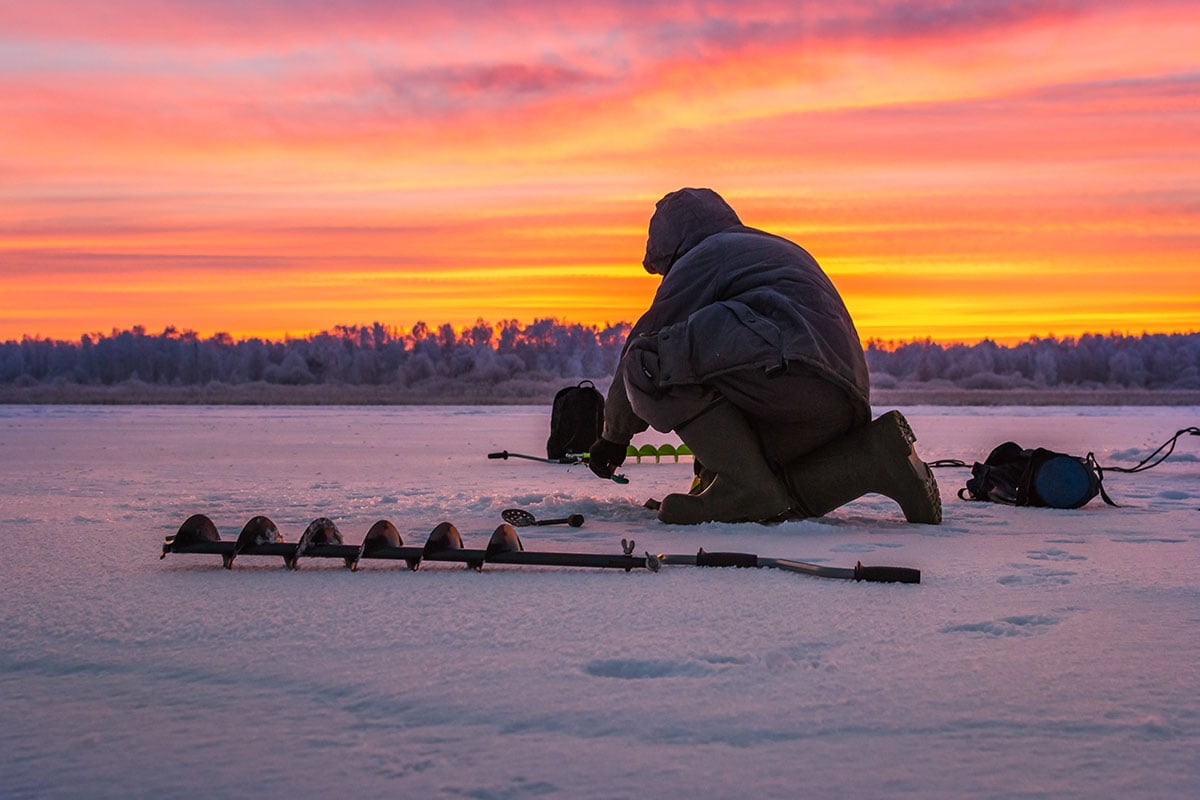
When ice fishing, you are not just battling the fish on the end of your line: you’re also battling the weather. Winter conditions bring a whole new set of challenges, making ice fishing a unique activity. It’s important to bring the right gear (and the right knowledge) before you set out on the hard water. This guide will provide you with everything you need to know to get started.
Essential Gear
In order of importance – Essential Ice Fishing Gear
- Ice fishing sled
- Rods/tip ups
- Auger
- Spike
- Ice skimmer
- Bucket
- Shelter
- Fish finder
- Bait & lures
Ice Fishing Sled
If you've ever attempted to carry your gear across the ice and snow, you know it's hard work.
Most serious ice anglers use sleds to make the job easier, but it’s important to find a good sled.
A flimsy, low-quality sled can be just as big of a headache as carrying your gear yourself. Having a good ice fishing sled will make finding a good fishing spot faster, safer, and a lot less work.
A good ice fishing sled should be rugged, but light, so you can haul your gear safely but quickly. A good sled should glide over the snow and ice with ease. Make sure your sled is big enough and sturdy enough, to carry all the ice fishing gear you'll need including a portable shelter, electric auger, multiple rods and reels, tip-ups, a heater, and a bait bucket. The right sled will ensure you can haul more equipment quicker and easier, so you can fish longer.
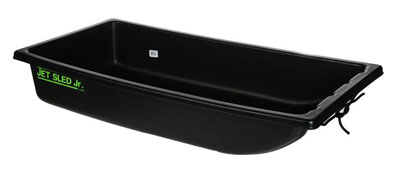
Available in three sizes, from 21x43 inches to 31x66 inches, there is a sled for everyone. Getting all your gear in one place, at a very low price, in a durable, easy-to-pull sled makes ice fishing much easier. Pack your shelter, rods, tip-ups, bait, and everything else in one easy-to-tow package.
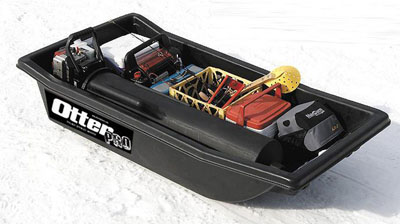
You’ll pay a little more for this sled, but the design is made exclusively for hauling gear across the snow, and pressure ridges on the ice. This is the most durable sled featured here, and though it costs more, the deeper body and upward bow make it a breeze to pull by hand or with an ATV across the ice.
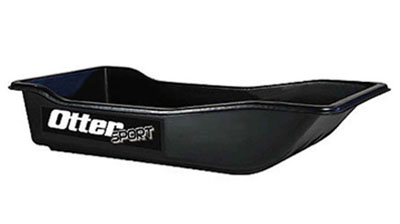
All in one solid construction, with an easy-to-pull keel, and available in three different configurations. This is a sled with many uses on the ice. Big enough to carry all your gear, but light enough to tow easily. Otter is known for high-quality outdoor equipment and the deep design of this sled seats buckets tightly and provides ample space for a variety of equipment.
Jigging Rod or Tip-Ups
There are two ways to ice fish: with a jigging rod or with tip-ups. A jigging rod is closer to the traditional fishing rod, while tip-ups are entirely unique to ice fishing.
Regulations vary from state to state, and you should check them before heading to the ice, but in general, you can jig with two rods, and spread out up to six tip-ups on most lakes.
A jigging rod is a short, 12 to 36-inch rod, with a reel attached that gives you excellent control above the ice hole while working jigs, lures, and live bait.
Tip-ups come in a wide variety of styles with older types made of wooden cross members, and more modern ones spring-loaded to set the hook on a strike and flip up a flag to let you know you have a fish on. (Explore types of ice fishing rods.)
Top 3 Ice Fishing Rods
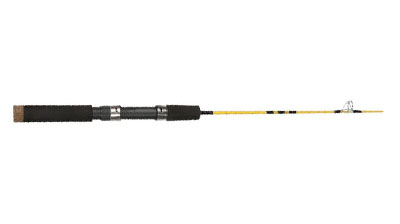
A little on the longer side at 36 inches, with a universal mount that will seat either a spinning, spin cast, or baitcasting reel. This single-piece, medium power rod is designed for four to 15-pound test line and handles lures from 1/4 to 5/8 ounce sizes. Best of all, it is a quality rod, at a very low price.

This is a heavy-duty rod, designed to catch big fish from deep under the ice. With seven eyes on a thick, 36-inch blank. If you’re after Northern pike, larger lake trout, or Lingcod, this might be worth a look. Take your favorite open water spinning reel and put it into cold weather duty. Heavy 12-pound monofilament line will handle lure weights to one ounce.

A slightly lighter version of the Mega Heavy Jawjacker, this 31-inch medium-heavy rod will handle six to 10-pound test line on a standard spinning reel. Made for work waters with moderate-sized fish like walleye, and perch. This is a quality, high-strength rod that can handle pressure even to 30 or 40 below zero conditions.
Top 3 Tip-Ups

This is a revolutionary design that incorporates both rod and tip-up into one assembly. This system works with all rods up to 30 inches long, and with a select few to 36”. The portable system allows you to set your favorite rod in the device, set the strike setting from light to heavy, and then does the rest for you. When a fish hits, it triggers a release that sets the hook automatically and pops a flag so you can see that it went off.
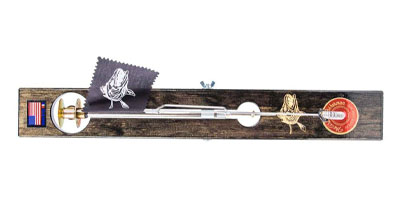
A venerable survivor of days gone by in ice fishing technology, but don’t let the name fool you. It says walleye, but it works for any species you can catch through the ice. This simple design, complete with a walleye flag, has been effective for over half a century. It comes at a hefty price in comparison with other tip-ups, but it delivers outstanding results.
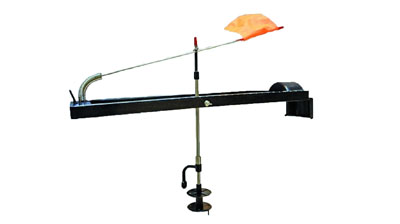
This represents a step back to simpler times with a modern twist. The attached reel rests below the tip-up in the water. This prevents freeze-up and lowers the cost of the entire assembly while retaining high sensitivity to even the lightest strikes. When a fish strikes, it spins the shaft just enough to pop up the flag, giving you time to set the hook. Once the fish is on, just lift the tip-up off the ice, take the reel and retrieve your catch.
Auger
You’ll need an auger to drill holes in the ice. But there are many different types of augers you can buy. If you plan on drilling a lot of holes through very thick ice, consider a gas or electric auger instead of a manual option. When targeting large fish, you will need to drill a wider hole.
So, the larger the species of fish you’re targeting, the larger your auger will need to be. Augers come in sizes from 6 to 12 inches. The larger the auger, the more torque required, and the more power to drill through the ice.

A little extra weight in an auger is a good thing, otherwise, you’re just dancing in circles instead of cutting through the ice. Weighing in at 6.5 pounds, with a length from four to five feet, this manual auger gets the job done quickly. Complete with replaceable blades it’s a great addition to pack on your sled.
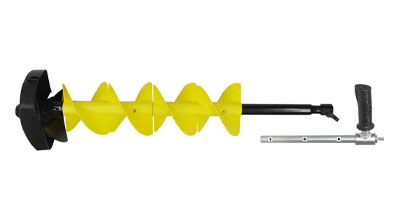
Just add your favorite cordless drill and you’re ready to quietly cut holes. Bring an extra battery for this 33-inch-long marvel. It’s shorter than standard augers since you’ll be bending over with a drill. If the ice is extra thick, a 14-inch extension can be quickly added to the auger for more depth.
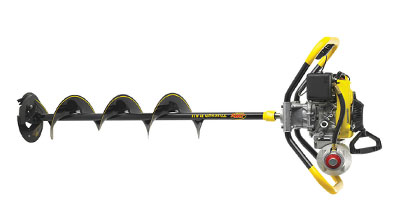
The biggest complaint many anglers have with gas-powered augers is mixing the fuel to get the correct gasoline/oil combination. Jiffy solves that problem with an easy starting auger that runs on small propane canisters. One or two pulls, even at temperatures well below zero is all you need, and there is no need to guess the choke setting since it doesn’t require one.
Spike
The original ice auger wasn’t an auger at all but just a steel bar with a sharp edge for chipping holes in the ice. A spike is the modern version of that steel bar and has an extra use as a walking stick to help you stay steady on rough sections of the lake. Some use it judiciously to test ice thickness as well. No matter the use, it’s a vital piece of equipment and you should always have a rope tied to one end, with the other around your wrist. This is the most commonly lost ice fishing equipment when someone breaks through the ice and loses their grip, sending it to the lake bottom.

This two-piece design is easy to carry, and just as easy to connect for chipping ice, or enlarging a hole that is already drilled. The lightweight shaft, with a heavy, sharpened steel chisel is perfect for quickly removing ice, even thick ice, and a good addition to your sled inventory.
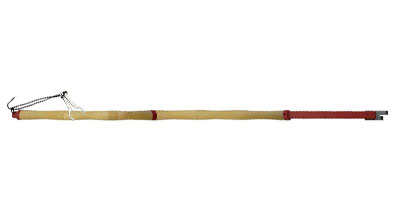
It’s back to basics with this chisel. A hardened two-headed steel chisel attached to a single hardwood shaft brings a nostalgic touch to the ice. The design takes you back to the 1950s, but it also chips ice on par with any modern chisel.
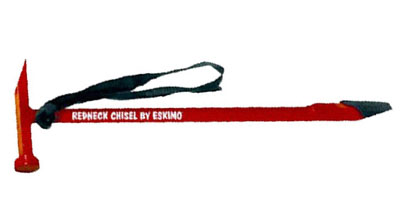
Maybe the most versatile single tool you can carry on your sled is this creative combination of ice axe, chisel, and hammer. It cuts and enlarges holes easily, and it drives stakes well when you’re anchoring your tent or sled against those gales so common out on the ice.
Ice Skimmers
We call them ice skimmers, but they’re really more similar to a ladle. On cold afternoons, and especially during night fishing when the temperature really drops, holes will quickly freeze over at the surface and continue until they’re solid ice again. An ice spoon lets you clean out floating ice chunks that accelerate the freezing process, keeping your hole open and ready to fish.
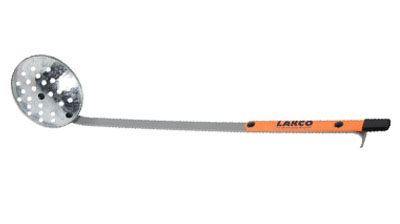
A skimmer with a small chisel just below the end of the 20-inch handle makes this a versatile, and essential tool for keeping your ice holes clear. The large ladle effectively scoops up large chunks of ice along with chips left over from your auger on a new hole.

If you’re not a fan of bending over or kneeling all day on the ice, this telescopic skimmer might be for you. Extendable from 24 to 36 inches, with a twist lock you can use even with heavy gloves, this skimmer will relieve your back and knees.
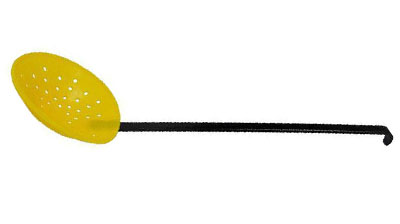
Inexpensive, with a 16-inch handle and a durable heavy-duty plastic skimmer, these are ideal for large fishing parties on the ice. Buy a handful and everyone can take care of their holes without wandering back and forth across hundreds of yards of open ice.
Bucket
They’re not glamorous, and they don’t get much attention online or on the store shelves, but buckets, plain old 5-gallon buckets are the backbone of every ice fishing adventure. You can save lightweight ones from painting projects, or from other sources, but these won’t last as long as a bucket designed specifically for the extreme temperatures and UV exposure you find on the open ice. They’ve been the backpack of ice anglers for a long time and their versatility keeps them out there.

What can you say? These are inexpensive, indispensable, and durable. You can pack your lunch in them, carry bait, supplies, or piles of gear and they’re easy to handle, easy to store, and perhaps best of all, you can use them once the ice is off for hunting, camping, or just around the house.

Yes, they cost a little more, but these are the premier utility bucket that ice anglers have relied on for a generation. You won’t crush one of these heavyweight buckets either when you’re using it as a stool on a brisk afternoon. Yeti is a world leader in storage containers and their utility bucket is arguably the best on the market.

It’s a good idea to pack at least one metal bucket in your gear, just in case you need to boil water, cook a meal, or are just looking for something more durable than plastic. This bucket is made of high-quality, 22-gauge stainless steel and will carry, cook, or heat just about anything you need.
Shelter
Ice fishing shelters (often called shanties) are optional. However, if you’re going to be fishing in freezing temperatures for hours at a time, investing in a shelter can make the experience much more enjoyable. Even basic, budget-friendly shelters will provide warmth and wind protection.
These “ice tents” are a bridge between sitting in the open and those permanent shacks you find all around the Great Lakes.
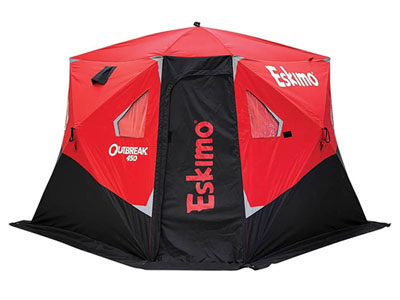
Incorporating the three things most anglers look for in a shelter, the Outbreak 450 has an interior height of 80 inches, 75 square feet of fishing area, and is made of a heavy-duty fabric that breaks wind. Reinforced grommets allow you to “nail” this shelter in place so your tent doesn’t become a sail when a gust hits.
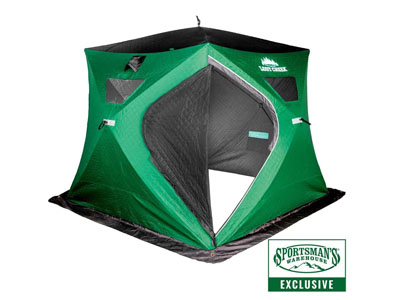
Designed for four anglers, you’ll find it much roomier for just a couple of ice fishermen at a time. The insulated walls are set in a “pop up” design that has the shelter ready in seconds. Pull it out of the bag, let it pop into place, and anchor it with the eight included stakes and pull straps.
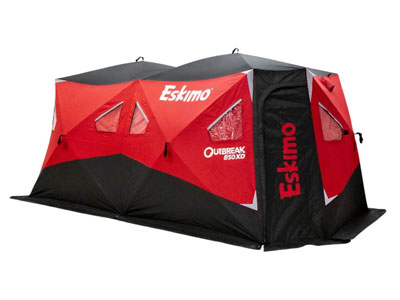
A mansion on the ice, that’s how this largest of all Eskimo shelters feels with just a few anglers inside. Rated for 9 people, it still weighs just 68 pounds. Insulated sides keep the heat inside from a small propane heater and allow you to brave the elements 24 hours a day.
Fish Finder
A fish finder displays water depth, structure and locates fish as well. Knowing what is under you and if there are any fish nearby is a valuable tool. It can also mark fish and show whether they are interested in your bait. You can use the same fish finder for ice fishing that you use during the warmer months.

Garmin offers more than just a method of finding fish under the ice, they’ve created a database of over 10,000 American lakes and ponds that you can download to your fish finder. This enables you to find structure where fish are likely to be. The adjustable seven-inch display is bright enough for the glaring midday sun but can be turned down for nighttime use.

Dual spectrum sonar, a detailed map database, and all of this packed into a lightweight portable package are the draw of the Humminbird Ice Helix. Easy to use, easy to set on the ice, and durable, this device will find its way to your boat during the summer months and produces great images no matter the season.

Dual spectrum sonar, a long-lasting battery, and the ability to zoom up to 16 times onto an object below you are all good reasons to consider this fish finder. The “Cadillac” of fish finders, Humminbird has packed all the bells and whistles you can find into this device, and as a result, you’ll pay a little more for it.
Bait & Lures
The limitations of fishing through a small hole in the ice doesn’t mean you don’t have a lot of options for bait and lures, because you do. Depending on the fish you’re after, your lures and bait will need to be adjusted. Almost every ice fishing species will hit a live minnow, and a few will do the same on night crawlers, mealworms, and other organic bait.
Lures won’t have the same “pop” as they do in moving water, but jigs, some spoons, and a few spinners will still do the trick through the ice.
Lures:
- Jigs
- Crankbait
- Spoons
- Bait
Jigs
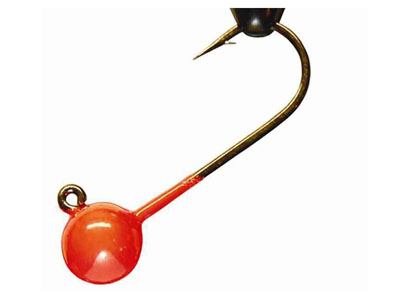
The simplest design, yet arguably the best as well. Hook a rubber minnow or other artificial bait to this jig and go to work. For walleye, a silver and black Gulp minnow with either a black or red colored jig does magic.
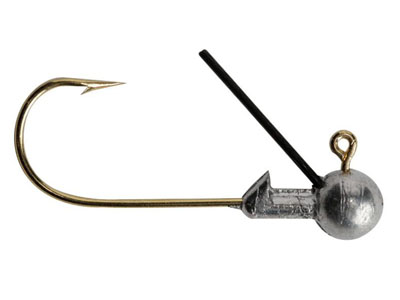
Just because it says crappie on the label doesn’t mean it won’t attract walleye, perch, or even a Northern pike. The magic of this design is that it is weedless. There is a wire attached to the head that pushes weeds out of the way as the jig is worked. Many ice fishermen shy away from weedy areas when they sometimes contain the biggest fish.
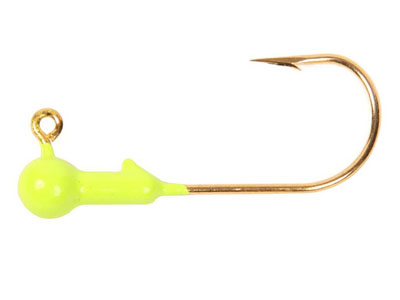
A smaller jig, weighing just 1/32 of an ounce, is a jig for smaller species such as perch, and crappie, though a big walleye or lake trout will hit this as well. Select a smaller rubber minnow and hook it behind the colorfully painted head and go to work.
Crankbait

Many anglers mistakenly assume that crankbaits don’t work through the ice, but they do. They’ll work in deeper water, on a still lake, and produce even better results if there is a current under the ice. Work them just like you do in open water, except you let them drop, then jerk slightly to simulate a swimming baitfish.

If crankbait has a name, it’s likely Rapala. The first, and still in many opinions, the best crankbait on the market, Rapala is dedicated to quality crankbaits. The DT works well through the ice, with its lip grabbing the water to create a tantalizing image of a baitfish to hungry predators swimming beneath the ice.
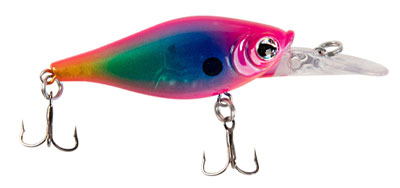
Designed to work in shallower water at depths from seven to 10 feet, this crankbait with its colorful pattern is a great lure for those sunny afternoons when live bait isn’t getting the job done. The extended bill creates movement with just the flick of the wrist and the sunlight filtering through the ice reflects off the lure.
Spoons

The colors are a little exotic, but the action is the same with all eight models Northland has created in this lure. The design resembles a fingerling perch or a shad when it moves in the water. The weight is distributed to enhance the vertical motion that dominates spoon action in still water beneath the ice.

This is an odd-shaped spoon, a little out of the ordinary, but just what you’re looking for if you’re after lake trout, Kokanee, or even crappie through the ice. A leaf-shaped lure with a double hook and a prominent eye, it resembles a shiner minnow in the water.
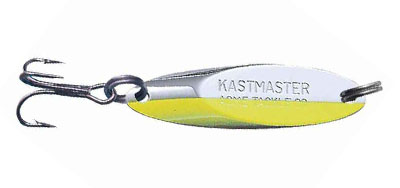
This is a combination spoon and rattling crankbait with a chamber that creates sonic vibrations in the water. It takes the reflection action of the colorful spoon and adds a little noise to get the fish to pay attention. It has good results with walleye and lake trout.
Bait
Live bait, especially minnows are the go-to option in ice fishing, particularly with tip-ups. All types of live bait have their place with certain species. We’ve created a chart for live bait with a little “how to” and what to look for when using it for specific types of fish.
Selecting a Spot
Finding a location to drill your holes and selecting a hole pattern to follow is equally as important as the bait you use, the style of tip-ups you set out, and how you jig.
Maps and fish finders are your best friend on a new lake, and locating your “secret spot” on an established lake is always a good idea.
You want to locate an inlet where water is still flowing into a lake, this brings more oxygen into the water, and baitfish will gather here. Setting your holes to follow the flow under the ice is a great idea too since some fish like trout, perch, and walleye will feed in schools. Getting those tip-ups all popping in succession makes a great day on the ice.
Look for structure like rock outcroppings and sunken logs that provide both protection and concealment for fish. The big ones use it to ambush and the smaller ones to hide.
When you’ve found a spot, drill your holes to match the structure beneath. Regulations vary in each state, so check before you drill too many holes.
Be creative in your hole pattern and keep the spot as clean as you found it when you’re finished. The next guy will appreciate that, so pay it forward.
Popular Ice Fishing Species
The good news is that the northern latitudes of the USA and Canada are full of tasty, hard-fighting fish. Bass aren’t a big ice fishing species, but you’ll still catch an occasional largemouth through the ice.
The one species that is best caught through the ice is burbot, also called ling cod, and in many areas simply ling. This is the ugliest freshwater fish you can catch, but also among the best eating. Other species are available as well.
Top Ice Fishing Species:
- Ling
- Walleye
- Northern Pike
- Perch
- Crappie
- Trout
- Bluegill
Ling
Often called “poor man’s lobster” these long narrow fish are easier to catch through the ice than at any other time. You’ll want to bottom bounce or suspend a minnow just above a weed bed for these guys.
Walleye
The most pursued fish on the ice. Walleye are considered the best-tasting freshwater fish and their habitat is widespread across the colder regions. Walleye prefer minnows, but they’ll hit jigs, spoons, jerkbait, and nightcrawlers too. They can reach 20 pounds so be ready to enlarge the hole if you tag one.
Northern Pike
Like any other species, Northern pike get hungry under the ice. They are the most aggressive fish you’ll find and will hit on minnows, cut bait, and jerkbait when presented properly. Most anglers just catch and release these fish, but if it’s a big one, have your camera ready for a quick photo before you toss it back into the water.
Perch
Next to walleye, perch are a preferred eating fish, they’re just smaller than their close relative the walleye. Perch will nest, meaning you’ll find huge schools of them huddling around structure. If you locate a nest, and they’re hungry, you’re about to have a busy day on the ice.
Crappie
Like perch, crappie are a schooling fish. If you locate a big school of them, set your holes in a double line on each side of the school, mix your bait with mealworms, night crawlers, and jig alongside the live bait with a small spoon, or jig. The fun will soon begin.
Trout
Rainbows and lake trout are the most likely sub-species of trout you’ll catch through the ice. They’ll hit jigs, spoons, jerkbait, and minnows and might show a little interest in night crawlers as well. Often the biggest trout from a lake are caught through the ice.
Bluegill
We often think of bluegill, pumpkinseed, and other sunfish as warm water species, but in Minnesota and Wisconsin, you can catch these smaller, tasty gamefish all year long. They’ll hit on waxworms, red worms, and sometimes on very small jigs. They have huge concentrations so if you find a good spot, you might catch a few dozen an hour when conditions are right.
Live Bait Chart by Species
| Type | How to present | Necessary tackle for tip-ups | Hole pattern | Species |
|---|---|---|---|---|
| Minnows | Hooked through the lip | Fluorocarbon leader, with braided line and split shot sinker | Double line 30 to 40 feet apart | Walleye, Northern pike, lake trout, burbot |
| Cut bait | Wrapped around a treble hook | Split shot sinker with fluorocarbon leader | Random within 30 yards of your central location | Northern pike, walleye, lake trout |
| Nightcrawlers | Hooked on a #6 hook | Monofilament with split shot | Random or zigzag pattern over known structure | Trout, walleye, perch, crappie |
| Worms | Hooked on a #10 or smaller hook | Monofilament with split shot – 4-to-6 pound test | Circle pattern around your location | Perch, crappie, bluegill, trout |
| Wax worms | Hooked on a #12 or smaller hook | Light Fluorocarbon leader | Circle pattern | Bluegill, perch, crappie |
| Leeches | Hooked on a #10 hook | Light fluorocarbon leader on braided line | Random pattern over submerged weed bed | Crappie, walleye, bass |
Conclusion
Be a good sport, pack in, and pack out everything you bring with you. Leave the ice looking like you were never there.
Be a good neighbor as well. When fish are hitting, the ice can be a crowded place. Stay close to your holes and don’t infringe on anyone else. If they’re having problems with a four-wheeler or other equipment, offer to help.
If you’re fishing overnight, leave a lantern on low or a light to mark your spot. Some anglers prefer to move under the stars with an ATV and neither of you wants to meet each other in an accident on the ice.
Dress appropriately, pay attention to incoming weather, and enjoy the solitude. Sound carries much farther on the ice, and will carry beneath as well since water, frozen or not, has excellent sound-carrying qualities.
Have a good time.